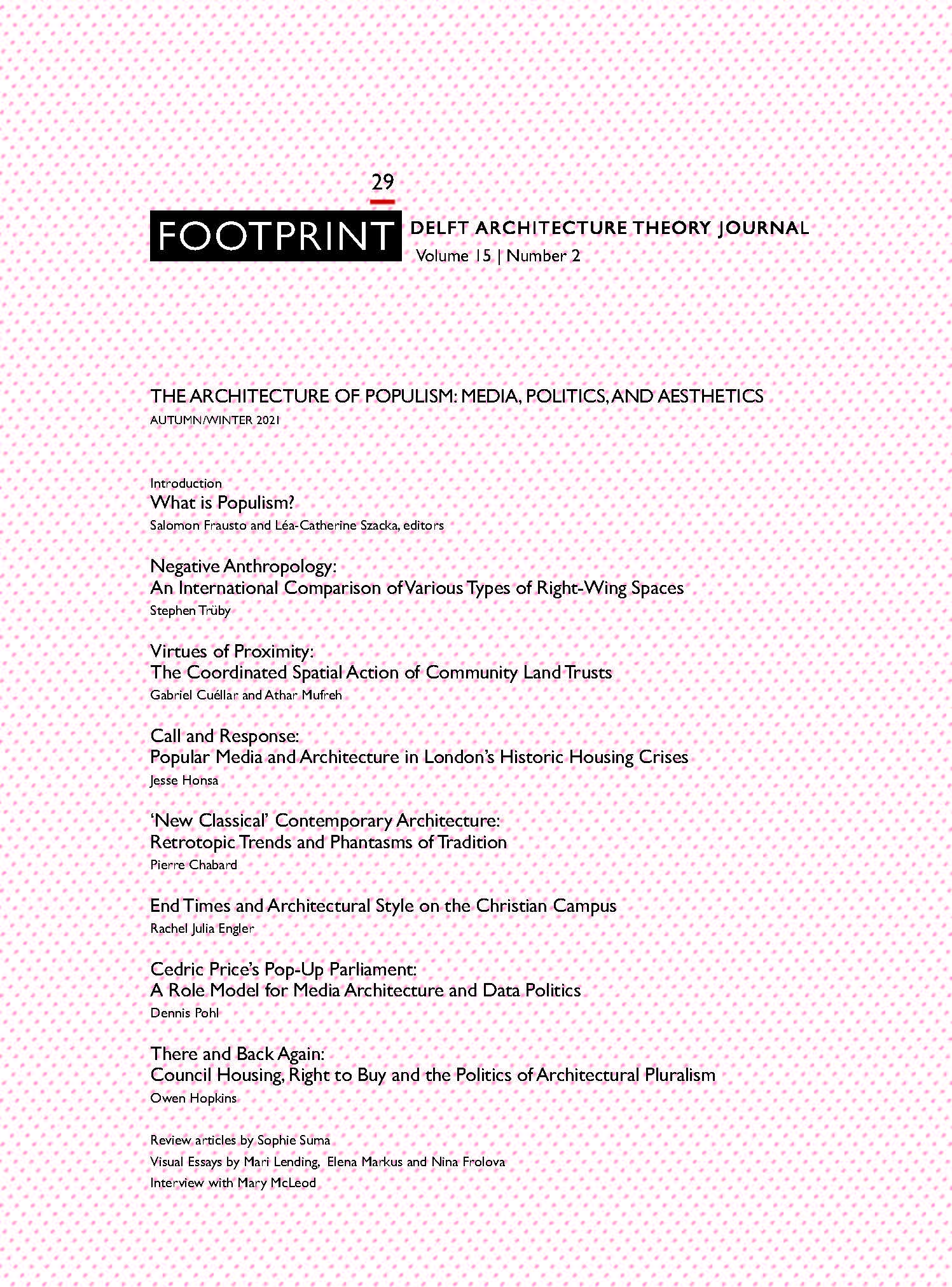Virtues of Proximity
The Coordinated Spatial Action of Community Land Trusts
DOI:
https://doi.org/10.7480/footprint.15.2.5391Abstract
Whereas real estate-driven development tends to invest in singular and concentrated sites, resident-led development thrives in scattered patterns. The properties of community land trusts (CLTs) — one of the foremost models of resident-led development whereby land is claimed and used by a community without landlords — are almost always dispersed in a context where every property line is a potential obstacle to development. What these populist landholdings lack in terms of economy of scale is compensated for by virtues of proximity. This article examines the historic phenomena of property scattering and spatial patterns of CLTs across the US, articulating the possibility of designing patterns of scattered landholdings that support the values of resident-led development.
References
Hogan, James, Scattered-Site Housing: Characteristics and Consequences, accessible at https://www.huduser.gov/portal/publications/pubasst/scatter.html (1996).
Homeless Policy Research Institute, “Outcomes in Single-Site and Scattered-Site Permanent Supportive Housing,” accessible at https://socialinnovation.usc.edu/wp-content/uploads/2019/04/Scattered-vs.-Single-Site-PSH-Literature-Review.pdf (April 2019).
Bendix Anderson, “Developers Help Fill Pressing Need With Scattered-Site Affordable Housing,” accessible at https://www.multifamilyexecutive.com/design-development/developers-help-fill-pressing-need-with-scattered-site-affordable-housing_o (September 4 2017).
Smith, Henry, “Semicommon Property Rights and Scattering in the Open Fields,” The Journal of Legal Studies, Vol. 29, No. 1 (January 2000). 131–169.
Smith, Everett G. Jr., “Fragmented Farms in the United States,” Annals of the Association of American Geographers, Vol. 65, No. 1 (March 1975). 58–70.
King, Russell and Steve Burton, “Land Fragmentation: notes on a fundamental rural spatial problem,” Progress in Human Geography, Vol. 6, No. 4 (December 1982). 475–494.
Quiggin, John, “Scattered Landholdings in Common Property Systems,” Journal of Economic Behavior and Organization, Vol. 9 (1988). 187–201.
Arnold, Zachary C.M., “Against the Tide: Connecticut Oystering, Hybrid Property, and the Survival of the Commons,” The Yale Law Journal, Vol. 124, No. 4 (Jan-Feb 2015). 1206–1250.
Davis, John Emmeus, “Origins and Evolution of the Community Land Trust in the United States,” accessible at https://community-wealth.org/content/origins-and-evolution-community-land-trust-united-states (2014).
Rose, Samuel W., “A New Way Forward: Native Nations, Nonprofitzation, Community Land Trusts, and the Indigenous Shadow State,” Nonprofit Policy Forum, Vol. 2, No. 2 (2011).
DeFilippis, James, Olivia R. Williams, Joseph Pierce, Deborah G. Martin, Rich Kruger, and Azadeh Hadizadeh Esfahani, “On the Transformative Potential of Community Land Trusts in the United States,” Antipode, Vol. 51, No. 3 (2019). 795–817.
Kruger, Richard, JamesDeFilippis, Olivia R. Williams, Joseph Pierce, Deborah G. Martin, Rich Kruger, and Azadeh Hadizadeh Esfahani, “The Production of Community in Community Land Trusts,” City & Community, Vol. 19, No. 3 (September 2020). 638-655.
White, Kirby, “Community Land Trusts Open the Door to Affordable Housing,” National Association of Realtors Common Ground (Winter 2013), https://www.nar.realtor/smart_growth.nsf/Pages/ocg_winter2003_community_trusts, accessed 31 October 2020.
Emily Thaden and Kim Graziani and Annie Stup, “Land Banks and Community Land Trusts: Not Synonyms or Antonyms. Complements,” Shelterforce (9 November 2016), https://shelterforce.org/2016/11/09/land-banks-community-land-trusts-not-synonyms-or-antonyms-complements/, accessed 31 October 2020.
Downloads
Published
Issue
Section
License
Copyright (c) 2022 Gabriel Cuéllar, Athar Mufreh

This work is licensed under a Creative Commons Attribution 4.0 International License.
- Authors retain copyright and grant the journal right of first publication with the work simultaneously licensed under a Creative Commons Attribution License that allows others to share the work with an acknowledgement of the work's authorship and initial publication in this journal.
- Authors are able to enter into separate, additional contractual arrangements for the non-exclusive distribution of the journal's published version of the work (e.g., post it to an institutional repository or publish it in a book), with an acknowledgement of its initial publication in this journal.





